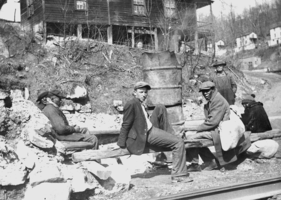 | Back to e-WV
| Back to e-WV
 The West Virginia Encyclopedia
The West Virginia Encyclopedia
 | Back to e-WV
| Back to e-WV
 The West Virginia Encyclopedia
The West Virginia Encyclopedia

With unemployment figures exceeding 80 percent in some counties, West Virginia was one of the states hardest hit by the Great Depression of 1929–41. All sectors of the economy suffered, and the vicissitudes of hard times have had an enduring impact on life and labor in the state.
In politics, the Depression ended a long era of Republican domination as Democrats took over the legislature and the governor’s office. Republican Governor William Conley (1929–33) called for increased appropriations for relief and sought federal help but faced a growing financial crisis as state revenues faded. In 1932, West Virginia voters approved a tax-limitation amendment to the constitution and voted overwhelmingly for the Democratic ticket headed by Franklin D. Roosevelt for president and Herman Guy Kump (1933–37) for governor. Popular because it promised tax relief for farmers and homeowners, the amendment’s unintentional consequences complicated the crisis. The limitations on property taxes denied to local governments their chief source of revenue and compelled the state to assume new powers over schools, roads, and indigent care. Kump and the legislature sought new sources of revenue through a mix of indirect taxes, including a consumer sales tax. In Washington, Congress quickly enacted Roosevelt’s New Deal program.
Debates over policy and patronage split Democrats into two factions. The statehouse faction, headed by Governor Kump, controlled state patronage and tended to oppose New Deal programs, while the federal faction, headed by U.S. Sen. Matthew Mansfield Neely, supported the New Deal and reaped the benefits of federal patronage. Governor Homer Holt, elected in 1936, was another statehouse-faction Democrat, and he generally continued the conservative fiscal policies of Kump. The statehouse Democrats boasted of their successes in paying off bonds and eliminating debt, but in the meantime the state provided meager support for education, roads, and other public services.
West Virginia’s leading industry, coal, underwent wrenching changes. In the early stages of the Depression, the industry suffered from a virtual collapse as mining companies failed and unemployment grew, leaving once busy coal camps idle and stranding thousands of miners and their families. New Deal legislation encouraged industrial cooperation on prices and wages and the development of collective bargaining, and under this impetus the United Mine Workers finally succeeded in unionizing the West Virginia coalfields. Many of the unemployed returned to the mines at higher wages, but the higher labor costs, competition from other energy sources, and falling prices of mining machinery eventually led to increased mechanization of the mines.
In the early days of the Depression, a return to the land led to an increase in the West Virginia farm population. But by the mid-1930s, many West Virginia farmers, finding it difficult to make a living on their mountain farms, began to abandon agriculture and to seek employment in towns and cities, often in other states. New Deal agricultural policies, plagued by ambivalence and inconsistency, provided support for soil conservation and land use planning but offered little to rescue the subsistence agriculture typical of West Virginia farmers.
At Eleanor, Arthurdale, and Tygart Valley, the New Deal experimented with planned communities which sought to combine agriculture and industrial work. Although the communities provided new homes and a better life for some, the results generally fell short of the hopes of their promoters.
Unemployed miners and farmers as well as other victims of the Depression found work in relief programs such as the Works Progress Administration and the Public Works Administration. These offered work to the unemployed and built needed facilities such as floodwalls in Huntington, the Kanawha Boulevard in Charleston, and airports, roads, bridges, schools, and health facilities throughout the state. Young people found help in the National Youth Administration, which provided job training and help to stay in school, and the Civilian Conservation Corps, which put young men to work on conservation projects in West Virginia and elsewhere. The state park system benefited greatly from CCC projects.
The pressure of federal policy also led to the reorganization of public welfare administration with the establishment of the Department of Public Welfare (later called the Department of Public Assistance) in 1932 and the closing of county poor farms after the establishment of social security in 1936. The new system required professionally trained social workers and led to the establishment of sociology and social work training programs at West Virginia University and the expansion of the social work profession in the state.
In 1940, Matthew M. Neely left his U.S. Senate seat to win the governorship for the federal-faction Democrats, opening the possibility of closer state-federal cooperation on New Deal matters, but the coming of World War II brought the New Deal to an end, leaving unresolved many of the problems of the Depression era.
Written by Jerry Bruce Thomas
Thomas, Jerry Bruce. An Appalachian New Deal: West Virginia in the Great Depression. Lexington: University Press of Kentucky, 1998.
Salstrom, Paul. Appalachia's Path to Dependency: Rethinking a Region's Economic History, 1730-1940. Lexington: University Press of Kentucky, 1994.
Olson, James S. The Depths of the Great Depression: Economic Collapse in West Virginia, 1932-1933. West Virginia History, (Apr. 1977).
Coffey, William E. "Rush Dew Holt, the Boy Senator, 1905-1942." Ph.D. diss., West Virginia University, 1970.
Gatrell, Albert Steven. "Herman Guy Kump: A Political Profile." Ph.D. diss., West Virginia University, 1967.
Haid, Stephen Edward. "Arthurdale: An Experiment in Community Planning." Ph.D. diss., West Virginia University, 1975.